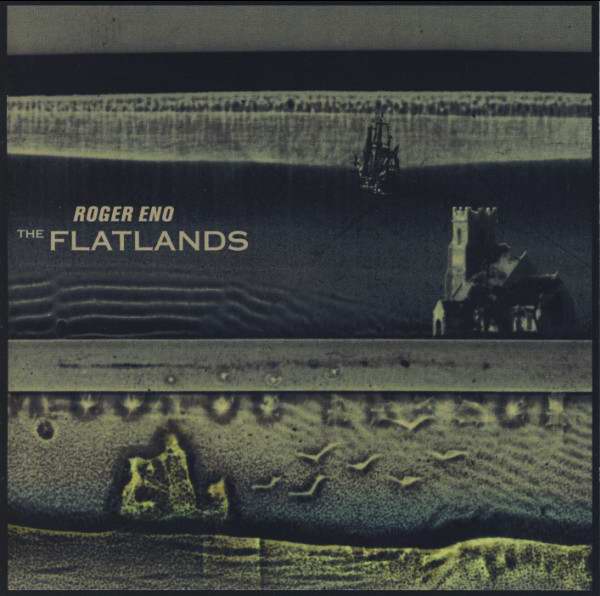
Exposé Online
What's old
Exposé print issues (1993-2011)
- 1 (October 1993)
- 2 (February 1994)
- 3 (May 1994)
- 4 (August 1994)
- 5 (October 1994)
- 6 (March 1995)
- 7 (July 1995)
- 8 (November 1995)
- 9 (March 1996)
- 10 (August 1996)
- 11 (February 1997)
- 12 (May 1997)
- 13 (October 1997)
- 14 (February 1998)
- 15 (July 1998)
- 16 (January 1999)
- 17 (April 1999)
- 18 (November 1999)
- 19 (May 2000)
- 20 (October 2000)
- 21 (March 2001)
- 22 (July 2001)
- 23 (December 2001)
- 24 (April 2002)
- 25 (September 2002)
- 26 (February 2003)
- 27 (August 2003)
- 28 (December 2003)
- 29 (April 2004)
- 30 (September 2004)
- 31 (March 2005)
- 32 (September 2005)
- 33 (May 2006)
- 34 (March 2007)
- 35 (January 2008)
- 36 (October 2008)
- 37 (July 2009)
- 38 (July 2010)
- 39 (Summer 2011)
Reviews
Roger Eno — The Flatlands
(Hannibal HNCD 1518, 1998/2006, CD)

In a 1990 Wire magazine interview, Brian Eno described a work in progress involving the performance of his synthesizer compositions by the Kreisler Orchestra. This intriguing idea never bore fruit, but here, Eno’s younger sibling Roger has crafted a suite of 18 miniatures for chamber orchestra that fulfills much of the promise of that unheard undertaking. Some pieces offer the players options for collective improvisation, imparting a refreshing spontaneity to the performance. The 11 players gracefully navigate the gentle swells of Eno’s simple melodies, with the extemporaneous passages virtually indistinguishable from the closely-composed sections. Roger Eno’s compositions have an open, unresolved character that sets his work apart from the classical tradition. While the composer never plumbs the profound emotional depths of such 90s neoclassical landmarks as David Darling’s “Dark Wood” or Gavin Bryars’ “The Last Days,” “The Flatlands” cultivates melancholy and loss into luxuriant beauty. By far surpassing Roger Eno’s earlier chamber efforts such as “Between Tides,” “The Flatlands” is the strongest work to date by a composer previously distinguished primarily by his family connections. The only flaw with The Flatlands is the lack of a strong closing track; the suite doesn’t conclude so much as evaporate.
by Michael Draine, Published 1999-04-01
Roger Eno's fifth individual release, The Flatlands, is solo piano and small string section focused on poignant themes, but delivered passionately. Imagine Brian Eno's Discreet Music without the tape loops, but just as passive, soothing, and thought-provoking. "Somewhere Above" begins the disc on a hopeful premise of English beauty, evoking unique claims for ownership of that modest commodity. Some of the arrangements remind me of Steve Morse's semi-classical pieces for the Dixie Dregs on "Just Once" or the Mahavishnu Orchestra as on "Mr. Johnson Watches the Sky." The fine set of eight violinists includes Lucy Shaw who recently toured with Bryan Ferry on his 2000 tour. Kate St. John is also a featured player on tracks such as "Walsingham" and "The Third Light," a mood-shaping vignette. "Missing Piece Number One" and "Missing Piece Number Four" rely on reflective keyboard passages which introduce altogether sorrowful remorse. Eno was very on target with this much overlooked masterpiece of sensitive splendor.
by Jeff Melton, Published 2002-04-01
Filed under: Reissues, Issue 17, 2006 releases, 1998 recordings
Related artist(s): Roger Eno, Kate St. John
What's new
These are the most recent changes made to artists, releases, and articles.
- Review: Earthbound - Earthbound
Published 2025-12-28 - Review: Olgoj - A Place to Rest
Published 2025-12-27 - Release: John Weider - John Weider
Updated 2025-12-26 19:13:54 - Artist: John Weider
Updated 2025-12-26 19:09:52 - Release: Moonrider - Moonrider
Updated 2025-12-26 18:51:45 - Artist: Moonrider
Updated 2025-12-26 18:49:51 - Release: Octopus Syng - Insanity Is the Song We Sing
Updated 2025-12-26 12:53:35 - Release: Tre Spiritus - Tre Spiritus
Updated 2025-12-26 12:49:13 - Artist: Tre Spiritus
Updated 2025-12-26 12:48:34 - Release: Arpia - Festa Grande
Updated 2025-12-26 12:42:27 - Release: Sigmund Freud - Risveglio
Updated 2025-12-26 12:37:54 - Artist: Sigmund Freud
Updated 2025-12-26 12:37:08 - Release: Davide Cedolin - Ligurian Pastoral, Vol II
Updated 2025-12-26 00:17:38 - Release: Davide Cedolin - Ligurian Pastoral
Updated 2025-12-26 00:15:05 - Artist: Davide Cedolin
Updated 2025-12-26 00:12:01 - Review: Kokkinià - The Last Are Lost from the List
Published 2025-12-26 - Review: Pymlico - Core
Published 2025-12-25 - Release: Various Artists - Soul of the Machine: A Celebration of the Life & Legacy of ARP Founder Alan R Pearlman
Updated 2025-12-24 15:58:08 - Review: Jussi Reijonen - Sayr: Salt / Thirst & Sayr: Kaiho – Live in Helsinki
Published 2025-12-24 - Review: TOC & Jean-Luc Guionnet - Quelques Idées d'un Vert Incolore Dorment Furieusement
Published 2025-12-24
